Music Makes Students Happier

Majorities of parents whose children are involved in music classes also credit music education for making them happier, more focused, more selfdisciplined, stronger academically and more helpful.

Majorities of parents whose children are involved in music classes also credit music education for making them happier, more focused, more selfdisciplined, stronger academically and more helpful.

Children who study a musical instrument are more likely to excel in all of their studies, work better in teams, have enhanced critical thinking skills, stay in school, and pursue further education.
We recently updated the care videos for several of the beginning instruments available on our Debut Rental Program. Below is the general care and maintenance video for saxophones, with instruction given by Sam Motter of our Retail Sales Staff.

“I would teach children music, physics, and philosophy; but most importantly music, for the patterns in music and all the arts are the keys to learning.”

Nearly 100% of past winners in the prestigious Siemens Westinghouse Competition in Math, Science and Technology (for high school students) play one or more musical instruments. This led the Siemens Foundation to host a recital at Carnegie Hall in 2004, featuring some of these young people, after which a panel of experts debated the nature of the apparent science/music link.
While searching for the perfect new trumpet, many customers encounter the dilemma of, “Well this horn has a standard leadpipe, but this horn has a reverse leadpipe. What’s that difference?” Thank you for asking!
A leadpipe on any trumpet is the main receiver for the instrument in which the mouthpiece fits into, and connects to the main tuning slide. The means in which the leadpipe connects to the main tuning slide is what constitutes the term “standard” (non-reverse) or “reverse”.
For standard leadpipes, the main tuning slide fits inside of the leadpipe as pictured below.
Players who are mostly playing at loud volumes usually prefer the standard option as there is less variance in the quality of sound at those levels compared to the reverse leadpipe.
Reverse leadpipes are simply the opposite, in which the leadpipe fits inside of the main tuning slide.
A reverse leadpipe will likely be noticeably longer than the standard option. This factor increases the distance in which there will be any small gap going from leadpipe to tuning slide, resulting in what most players describe as less air resistance and more consistent intonation.
Ultimately, what is best for you will require being able to compare several options side by side in order to determine what instrument feels, plays, and sounds the best based on your own personal style.
For those in the market for a new trumpet, you are in luck! Here is a list of our trumpets here at Paige’s, sorted by leadpipe designation.
Standard (non-reverse) Leadpipe:
Yamaha- YTR5335 (GSAL, GSIIAL), YTR8335 (II, SIIS, LAS), YTR9335 (CHSII, NYSII)
Bach- 180S37, 180S43
Reverse Leadpipe:
Yamaha- YTR5330MRC (Mariachi), YTR8335IIRS, YTR8345IIS,
Jupiter- JTR1100S
All customers are more than welcome to come in and try out all of the horns in our store at any time in order to find his/her best fit!

Playing an instrument teaches kids to persevere through hours, months, and sometimes years of practice before they reach specific goals, such as performing with a band or memorizing a solo piece.

Perseverance is developed and strengthened through music education.